The Juno Mission to Jupiter
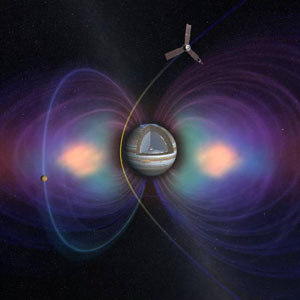 If all goes well, in 2011 the Juno spacecraft will begin a five-year voyage to Jupiter on a robotic mission to investigate the major unanswered questions about the largest of the giant worlds. Beneath its clouds, Jupiter holds secrets about our Solar System's early history. Juno will unlock many of these secrets, while shedding light on how planet formation unfolds in other star systems.
If all goes well, in 2011 the Juno spacecraft will begin a five-year voyage to Jupiter on a robotic mission to investigate the major unanswered questions about the largest of the giant worlds. Beneath its clouds, Jupiter holds secrets about our Solar System's early history. Juno will unlock many of these secrets, while shedding light on how planet formation unfolds in other star systems.
The Juno Mission Homepage
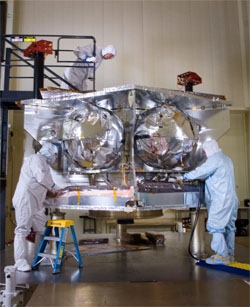 Assembly began April 1, 2010, for NASA's Juno spacecraft in the high-bay cleanroom at Lockheed Martin Space Systems in Denver, Colo. In this picture, workers are readying the spacecraft's propulsion module.
Assembly began April 1, 2010, for NASA's Juno spacecraft in the high-bay cleanroom at Lockheed Martin Space Systems in Denver, Colo. In this picture, workers are readying the spacecraft's propulsion module.
There are some BIG unanswered questions about the giant planets...
-
When did gas giants like Jupiter form? How do Jupiter and Saturn differ from the "ice giants" Uranus and Neptune?
-
What is the history of water in our Solar System?
-
We see a lot of giant planets around other stars. What does our Solar System tell us about these extrasolar planetary systems, and vice versa?
|
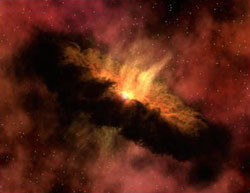
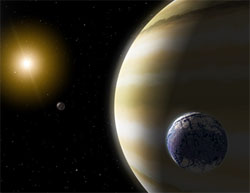
|
Juno will help answer these questions.
Juno's Science Objectives
|
Origins
Determine the abundance of water and place an upper limit on the mass of Jupiterís solid core to decide which theory of the planet's origin is correct.
Interior
Understand Jupiter's interior structure and how material moves deep within the planet by mapping its gravitational and magnetic fields.
Atmosphere
Map variations in atmospheric composition, temperature, cloud opacity and dynamics to depths greater than 100 bars at all latitudes.
Magnetosphere
Characterize and explore the three-dimensional structure of Jupiter's polar magnetosphere and auroras.
|
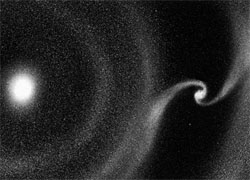

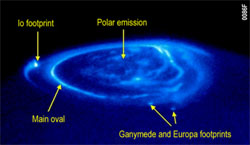
|
Interior of Jupiter
 Existence & size of the planet's solid core helps discriminate among giant planet formation theories Ė which one is correct or are new explanations needed?
Existence & size of the planet's solid core helps discriminate among giant planet formation theories Ė which one is correct or are new explanations needed?
Whether the planet accreted onto a solid core or resulted from gravitational collapse of the solar nebula leads to different histories for Jupiter
Structure of Jupiter tells us how the interior rotates
Gravity
 Precise measurements of spacecraft motion measure Jupiter's gravity field
Precise measurements of spacecraft motion measure Jupiter's gravity field
The gravity field tells us about how the mass is distributed inside the planet
Tides caused by the moons provide further clues about the planetís interior structure
Jupiter's Interior & Atmosphere
 Microwave antennas (radio waves) probe deep into the cloud layers Ė just the very top of the atmosphere, where weather occurs
Microwave antennas (radio waves) probe deep into the cloud layers Ė just the very top of the atmosphere, where weather occurs
Magnetic fields probe into the region where the magnetic field is generated Ė the metallic hydrogen layer
Gravity fields probe into the central core region
Storm Warnings
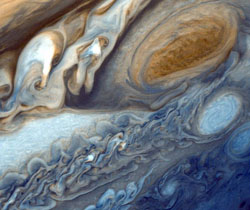 The Great Red Spot on Jupiter is 20,000 km long and has been followed by observers on Earth since the telescope was invented 400 years ago. This huge storm is made visible by variations in the composition of the cloud particles.
The Great Red Spot on Jupiter is 20,000 km long and has been followed by observers on Earth since the telescope was invented 400 years ago. This huge storm is made visible by variations in the composition of the cloud particles.
Juno's Microwave Instruments sense the deep atmosphere
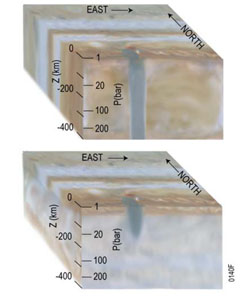 How deep are the roots of Jupiterís storms and other cloud features? We don't know!
How deep are the roots of Jupiterís storms and other cloud features? We don't know!
They could be connected to deep movements of the interior, or they could be shallow surface features
Jupiter's Magnetic Field
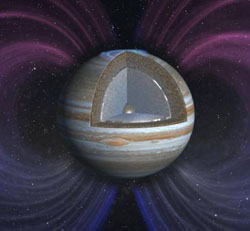
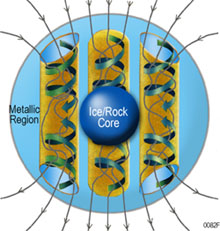
Precise magnetic field measurements unveil fundamental processes that generate the planet's powerful magnetic field.
Juno's polar orbit provides complete mapping of planetís asymmetric and highly structured field.



